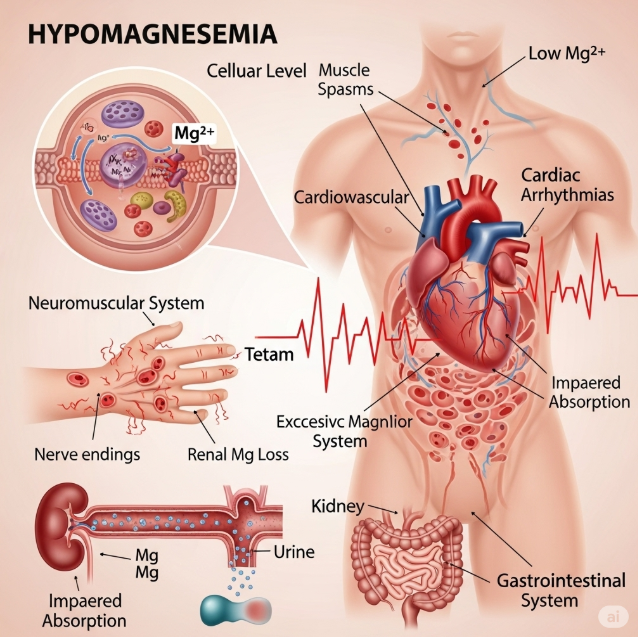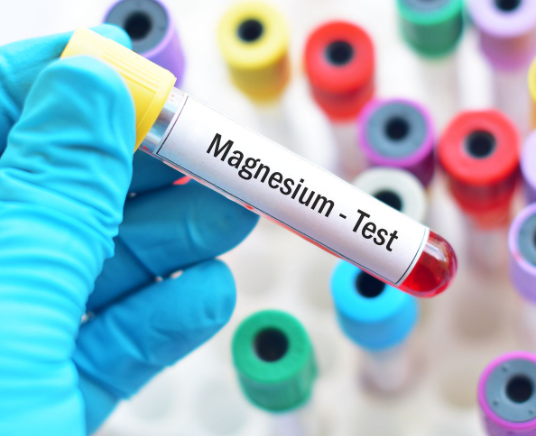Hypomagnesemia is an electrolyte disturbance characterized by a low level of magnesium in the blood, typically defined as a serum magnesium concentration of less than 1.8 mg/dL (or 1.46 mg/dL in some sources). This condition can be mild or severe and often occurs alongside other electrolyte imbalances like low calcium and potassium levels.
Magnesium is an essential mineral for many bodily functions, including nerve and muscle function, heart rhythm, blood pressure regulation, and bone development. A deficiency can result from inadequate intake, poor absorption in the intestines, or excessive excretion by the kidneys. While some people may not experience any symptoms, others may develop neuromuscular and cardiovascular issues, such as muscle spasms, tremors, and abnormal heart rhythms.

Causes:
- 1. Inadequate Intake or Absorption:
- Starvation or malnutrition.
- Alcohol use disorder.
- Gastrointestinal conditions that lead to poor absorption, such as chronic diarrhea, celiac disease, or inflammatory bowel disease.
- Gastric bypass surgery.
- 2. Increased Excretion:
- Kidney disorders that cause excessive magnesium loss in urine.
- Excessive urination (polyuria), which can occur in conditions like uncontrolled diabetes.
- Certain medications, including diuretics, proton pump inhibitors, and some antibiotics.
- 3. Other Medical Conditions and Factors:
- Burns over a large area of the body.
- Acute pancreatitis.
- Hyperaldosteronism.
- Aging, as magnesium becomes more difficult to absorb.
- “Hungry bone syndrome,” which can occur after parathyroid gland surgery.
Symptoms:
- Nausea and vomiting
- Loss of appetite
- Fatigue and weakness
- Tremors
- Muscle spasms or cramps
- Numbness and tingling in the hands and feet
- Abnormal eye movements (nystagmus)
- As the condition worsens, more severe symptoms can develop, such as:
- Seizures
- Abnormal heart rhythms (arrhythmias)
- Changes in personality, including apathy, delirium, and psychosis
- Tetany (involuntary muscle contractions)
- Dizziness
- Confusion
- Coma

Treatment:
- Treatment of Hypomagnesemia
1. Oral Magnesium (for mild to moderate cases)
Magnesium oxide, magnesium gluconate, or magnesium chloride tablets.
Taken daily until magnesium levels normalize.
Side effects: may cause diarrhea if taken in high doses.
2. Intravenous (IV) Magnesium (for severe cases)
Magnesium sulfate infusion in hospital.
Used when magnesium is very low, or if patient has seizures, arrhythmias, or cannot take oral supplements.
3. Dietary Sources (long-term management)
Leafy green vegetables (spinach, kale).
Nuts and seeds (almonds, cashews, pumpkin seeds).
Whole grains, beans, bananas, avocados.
Dark chocolate (moderate).
4. Correct Underlying Cause
Stop or adjust medications that waste magnesium (like some diuretics or proton pump inhibitors).
Treat diarrhea, malabsorption, or alcoholism.
Correct associated low potassium and calcium, since they often occur together.
